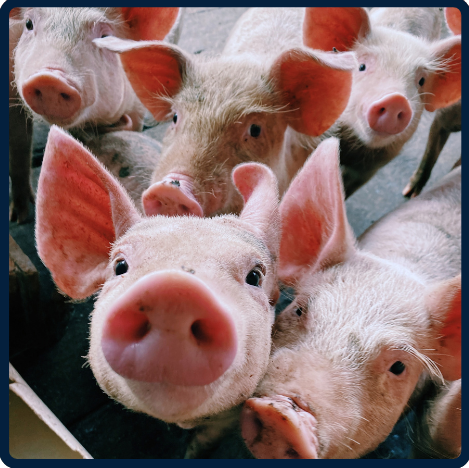Animal Control

For many of us owning livestock and pets is an important—and rewarding—part of rural life in Beaver County. Whether you live on an acreage, a quarter section, or a hamlet lot, our region is well suited for animal ownership.
With this privilege comes responsibility. Animal owners play a vital role in ensuring their animals are healthy, well cared for, and do not negatively impact the quality of life of their neighbours. Responsible ownership means understanding local regulations, following best practices for animal care, and helping maintain safe, respectful communities for everyone.
This page is packed with information and resources to help you navigate animal ownership in Beaver County. You'll find guidance on understanding common issues that can arise, how to effectively report concerns, what to expect after making a report, your responsibilities as a complainant, and other key details to support responsible ownership and community safety.
The overall aim of Beaver County Protective Services is to help make our County the safest possible place to live and work—no matter your lifestyle. We achieve this through knowledgeable, consistent bylaw enforcement and by applying a wide range of municipal best practices to support safety, respect, and community well-being.
Dog Limits in Beaver County
(Section 9, in the Animal Control Bylaw)
In Hamlets, Country Residential parcels, Inter-Municipal Development Plan areas, or residential lots under 0.81 ha (2.0 acres):
- Maximum of 4 household pets total
- Up to 3 dogs allowed
On residential parcels over 0.81 ha (2.0 acres), agricultural, or non-residential land:
- Up to 3 dogs allowed
Your Responsibilities as a Dog Owner in Beaver County
(Section 4, in the Animal Control Bylaw)
If you own a dog in Beaver County, here are a few key responsibilities to help keep everyone safe and comfortable:
- Keep your dog under control. Dogs must not run at large and should always be on a leash when off your property.
- Respect shared spaces. Dogs are not allowed in schoolyards or cemeteries.
- Be mindful of female dogs in heat. They must be securely housed and confined during this time.
- Prevent the spread of illness. If your dog has a communicable disease, keep them safely confined and away from other animals and people.
Animal & Bird Limits for Acreages in Beaver County
If you live on an acreage between 2.0 ac and 39.9 ac in a Hamlet, Country Residential district, an Inter-Municipal Development Plan area, or next to one of these zones, there are specific rules for how many animals or birds you can keep.
Here’s how it works:
| Parcel Size | Allowed Animal/Bird Units |
| 2.0 – 2.99 ac | 1 unit |
| 3.0 – 3.99 ac | 2 units |
| 4.0 – 4.99 ac | 3 units |
| 5.0 – 5.99 ac | 4 units |
| 6.0 – 9.99 ac | 5 units |
| 10.0 ac or more | 5 units+* |
*Examples:
- 13.0-acre parcel: 5 units (for the first 10 acres) + 2 units (for the additional 3 acres) = 7 units.
- 25-acre parcel: 5 units (for the first 10 acres) + 5 units (for the second 10 acres) + 4 units (for the additional 5 acres) = 14 units.
What Counts as One Animal/Bird Unit?
- 1 horse, donkey, mule, or ass
- 1 llama or 2 alpacas or guanacos
- 1 cow, steer (over 1 year), or 1 swine
- 2 calves (up to 1 year old)
- 15 chickens
- 10 ducks, turkeys, pheasants, geese, or similar fowl
- 3 sheep or goats
- 20 rabbits or similar rodents
- 2 ostriches, emus, or other ratites*
*Special Note for Ostriches, Emus, or Ratites
If you keep ostriches, emus, or other large flightless birds on a residential parcel, you must have a secure 1.8 m (6 ft) high perimeter fence made of tight-lock game fencing or chain link with sturdy steel or wooden posts around the pen area.
If you want to keep more animals than normally allowed under the bylaw limits, you can apply for an Over-Limit Permit, as per section 11, of the Animal Control Bylaw.
Here’s how it works:
- Apply in writing to Beaver County’s Community Peace Officer.
- The Officer will review your request and decide whether to:
- Approve it
- Approve it with specific conditions
- Or refuse the permit
- If approved, you’ll need to pay the permit fee (set by bylaw) before receiving your permit.
- Over-Limit Permits are valid for three calendar years and can be renewed with another fee payment.
NOTE: Permits are not transferable to other properties or owners.
Dogs provide both security and companionship, but barking can become a problem—especially in hamlets and acreage subdivisions. While some barking is normal in rural life, excessive barking can seriously disturb neighbours.
When investigating complaints, officers consider:
-
Time of day: Barking at night is especially disruptive, like a car alarm for sleeping neighbours. Daytime barking can also affect quality of life.
-
Frequency: How often barking starts. Outdoor dogs often react more to triggers and bark longer.
-
Duration: Owners are expected to respond and quiet barking. Unattended dogs may bark long after the trigger is gone.
-
Size and number of dogs: Larger or multiple dogs can be more disruptive.
-
Location: Kennels against buildings can amplify sound. Dogs near property lines or roaming loose can spread the noise. Complaints must identify the exact address of the barking dog.
-
Noise sensitivity of complainants: Officers balance individual sensitivity with what’s reasonable for the area.
How is “excessive” barking determined?
A signed Barking Log is required, showing at least a week of start/stop times and details on how the barking disturbed daily life (e.g. woke you up, disrupted TV). This is often the only evidence available.
Barking Log
Tips to Reduce Your Dog’s Barking
- Bring dogs inside at night (house or outbuilding).
- Provide warm, secure outdoor housing.
- Move kennels/doghouses as far from neighbours as possible.
- Consider a bark (shock) collar, but check daily for fit and function to avoid injury.
- Reduce the number of dogs you keep.
For dog attacks that result in a person being injured or an animal being killed:
-
Call 911 or County Enforcement Dispatch immediately.
-
RCMP response: An RCMP officer may attend to maintain safety, gather evidence, and if needed, seize the dog.
-
Impoundment: If the dog is seized, Beaver County’s Kennel Contractor will be called to impound it.
-
Follow-up: Beaver County Enforcement Services will continue the investigation as a priority in the next few business days.
- Vicious Dog Declarations: The County has strict rules for keeping dogs declared "vicious" under the Animal Control Bylaw. The County most often will accept voluntary surrender of a Vicious Dog to increase public safety, where circumstances warrant.
Beaver County welcomes the opportunity to assist with stray dogs and other animals contained and held in the County. We see to the transport of dogs to a secure impound and provide any vet care needed. We also land them in a safe and warm home at the end of the ordeal either with their original owner or a new one.
Report stray animals you see or capture by:
- Calling Beaver County Enforcement Services at 780-663-3730 (option #3 or ext. 1002) to speak to a call-taker,
- Calling the Enforcement Services officer direct line at 825-385-0062,
- By submitting a message online through our contact form.
Note, stray dogs are picked up asap, but it can take as long as 48 hours from the time you call. Please be prepared to hold the dog until Enforcement Services can make arrangements.
To register your animal, please complete:
Animal Registration Application (Printable) or,
Animal Registration Application (Fillable)
Then submit it to the County Office.
Complaints
To file an animal control complaint with Beaver County, please call the County Office at 780-663-3730, or submit a message to Enforcement using our Contact form.

